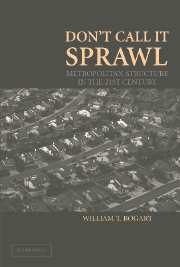Book contents
- Frontmatter
- Contents
- Acknowledgments
- 1 The World of Today
- 2 Making Things Better: The Importance of Flexibility
- 3 Are We There Yet?
- 4 Trading Places
- 5 Downtown: A Place to Work, a Place to Visit, a Place to Live
- 6 How Zoning Matters
- 7 Love the Density, Hate the Congestion
- 8 Homogeneity and Heterogeneity in Local Government
- 9 The World of Tomorrow
- Notes
- References
- Index
2 - Making Things Better: The Importance of Flexibility
Published online by Cambridge University Press: 02 December 2009
- Frontmatter
- Contents
- Acknowledgments
- 1 The World of Today
- 2 Making Things Better: The Importance of Flexibility
- 3 Are We There Yet?
- 4 Trading Places
- 5 Downtown: A Place to Work, a Place to Visit, a Place to Live
- 6 How Zoning Matters
- 7 Love the Density, Hate the Congestion
- 8 Homogeneity and Heterogeneity in Local Government
- 9 The World of Tomorrow
- Notes
- References
- Index
Summary
As children we were told that “sticks and stones may break my bones but names will never hurt me.” The world in which we live is often described as sprawl, a loosely defined or indefinable set of problems to be solved. This automatically creates pressure on public policy to solve the problem, in this case by changing the form of the city. On the other hand, if the world in which we live is better defined as a city-state composed of trading places, then there are different implications for policy. So as adults we know “sticks and stones may break my bones but names can lead to bad public policy.”
One reason it is important to be as clear as possible in describing problems is because a distorted presentation by partisans can lead to support for potentially inappropriate public policy. I like to illustrate the problem with the following example. In a book published by the Natural Resources Defense Council titled Once There Were Greenfields: How Urban Sprawl Is Undermining America's Environment, Economy, and Social Fabric (Benfield et al. 1999), the authors hold up Los Angeles as “the best-known example of sprawl in America”. To emphasize the problem presented by Los Angeles, they point out that “Greater Los Angeles is now said to occupy space equivalent in size to Connecticut”. This sounds damning indeed.
- Type
- Chapter
- Information
- Don't Call It SprawlMetropolitan Structure in the 21st Century, pp. 20 - 38Publisher: Cambridge University PressPrint publication year: 2006



